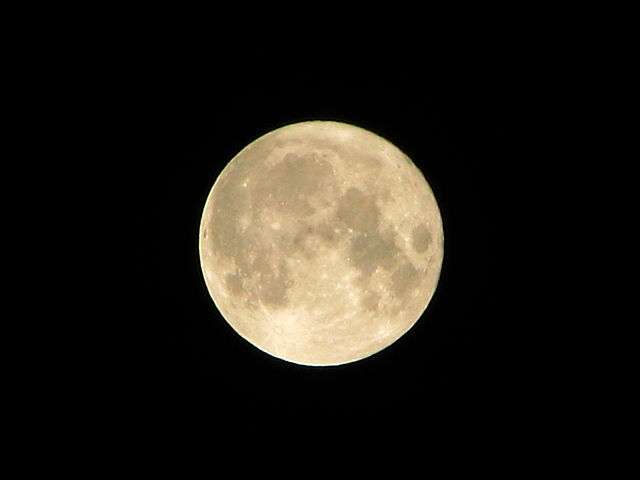Sometime around 1645, William Pynchon wrote down the names given to each full moon by a tribe of Abenaki Indians.
Pynchon, an English colonist, founded Springfield, Mass. He lived near and traded with Abenaki tribes. A fragment from his account book, probably written in late 1645, lists the names of the moons in an Abenaki dialect from a tribe he doesn’t specify. They may have been from the Agawams or the Woronocos.
English colonists would adopt the practice of naming each full moon, creating some of their own names or using traditional European names such as ‘Milk Moon’ or ‘Mother’s Moon’ The Maine Farmer’s Almanac started to publish a list of the full moon names around 1930, and the Old Farmer’s Almanac does it to this day.
Full Moon Names
The year started with the spring moon, according to Pynchon. It was known as Squannikesos, “When they set Indian corne’ in part of April and part of May.”
The second month, in late May and June, was Moonesquan Nimockkesos. Pynchon described it as :when women weed theire corne.”
The rest of the months are as follows, with Pynchon’s notes:
3. Towwakesos–when they hill Ind[ian] corne (pt of June & pt of July)
4. matterl lawawkesos–when squashes are ripe & Ind[ian]beans begin to be eatable
[5.] micheeneekesos — when Ind corne is eatable
6. pah[?]quitaqunkkesos–ye middle between arvest & eating Ind corne
7. pepewarr–bec: of white frost on ye grass & grain
8. quinnikesos
9. papsapquoho, about ye 6.th day of January or, Lowatannassick: So caled bec: they account it ye middle of winter.
10. Squo chee kesos–bec ye sun hath strength to thaw
11. Wapicummilcom–bec ye ice in ye river is all gone (pt of February & pt of March)
12. Namassack kesos–bec of catching fish (pt of March & pt of April)
Other Indian tribes had other names for the moon.
The Abenaki tribe lived in Maine, New Hampshire, Vermont and eastern Quebec. Anthropologists today divide the Abenaki into eastern tribes in Maine and western tribes in Vermont.
In colonial New England, the French called them Abenaqui or Oubenaqui; the English called them Eastern Indians. Eventually the Europeans drove many of them to take refuge at Saint Francis (Odanak) and Becancour (Wolinak), French mission villages on the St. Lawrence River. English and Americans often called all the Western Abenaki the St. Francis Indians.
They called themselves Wabanaki, though the Wabanaki Confederacy includes the Passamaquoddy, Maliseet and Micmac of northern Maine and the Canadian Maritimes.
English Full Moon Names
Here is the Old Farmers Almanac’s list of the English full Moon names.
January: Wolf Moon (or Old Moon)
February: Snow Moon (or Hunger Moon)
March: Worm Moon (or Crow Moon, Crust Moon, Sugar Moon, Sap Moon)
April: Pink Moon (or Sprouting Grass Moon, Egg Moon, Fish Moon)
May: Flower Moon (or Corn Planting Moon, Milk Moon)
June: Strawberry Moon (or Rose Moon, Hot Moon)
July: Buck Moon (or Thunder Moon, Hay Moon)
August: Sturgeon Moon (or Red Moon, Green Corn Moon)
September: Harvest Moon (or Corn Moon, Barley Moon)
October: Hunter’s Moon (or Travel Moon, Dying Grass Moon)
November: Beaver Moon (or Frost Moon)
December: Cold Moon (or Long Nights Moon)
These days we have a new name for the full moon when its closest to the earth: a supermoon. The supermoon looks brighter and bigger than an ordinary full moon. In 2020, moongazers could watch two supermoons, on March 9 and April 7.
Photo of the full moon by By Michael Gil – originally posted to Flickr as Howling at the Moon, CC BY 2.0, wikimedia commons. This story about the full moon names was updated in 2023.





3 comments
Why are your web programmers so inept they cannot figure out that I have already have your website email – every time – I mean every time – that popup window comes up saying get on the email list – if I go to 5 pages in a row at your site that window pops up 5 times – are you trying to drive customers away? Are you saying we do not want anyone on our website so we put up a blockade for every page you try to access?
[…] 22A was a trail that between north and south in western Vermont. The St. Francis Indians came down from Canada along the trail by Lake Champlain to find warmer fishing grounds. The trail […]
[…] tracked down her son, now 11, who didn’t know her and spoke only broken English. He knew perfect Abenaki, however, after living with them for three […]
Comments are closed.